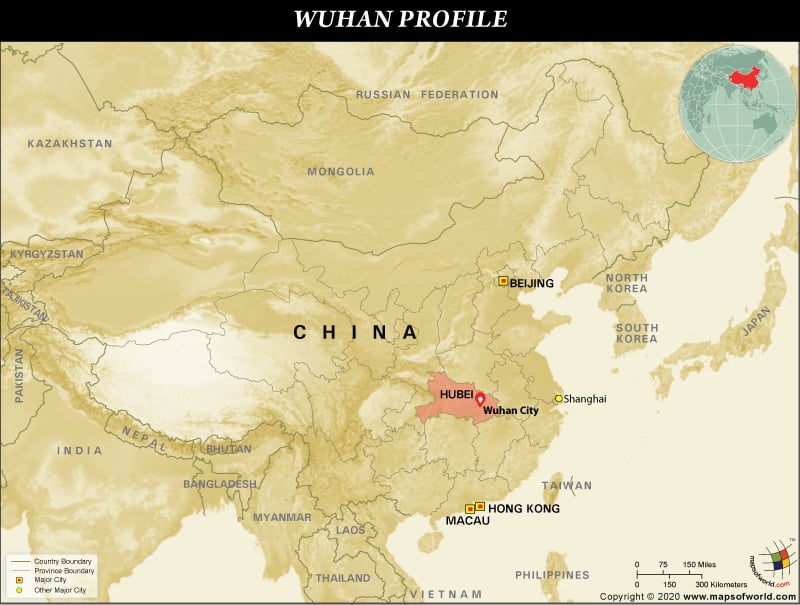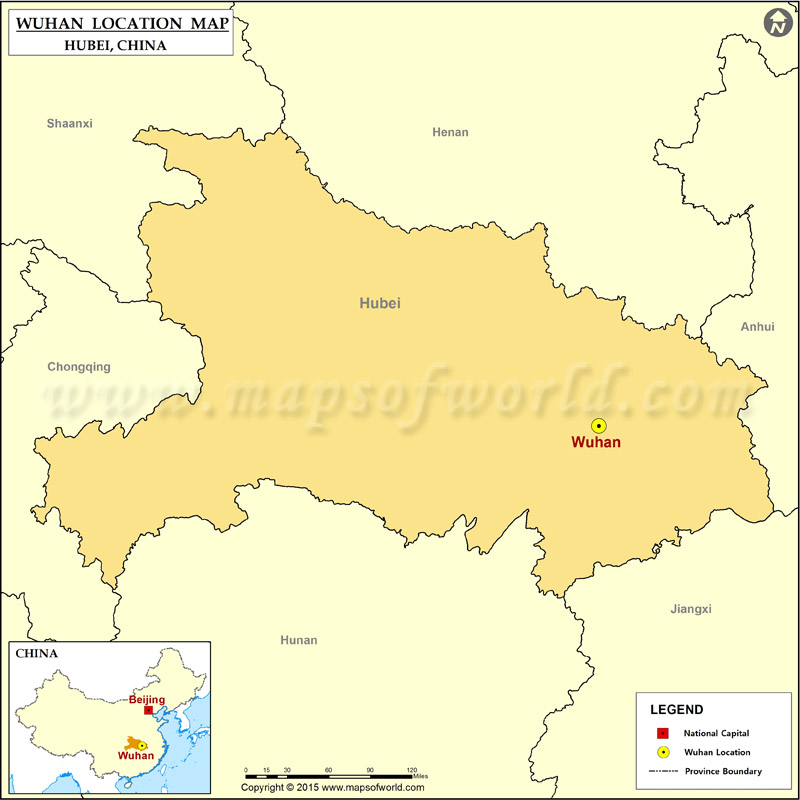Key Facts of Wuhan; The Epicenter of Coronavirus Outbreak

Where is Wuhan?
Wuhan City is located along the Yangtze River in the east-central Hubei province of China. It is situated at the confluence of the Han River and the Yangtze River. Along the Yangtze’s middle reaches, to the East of the Jianghan Plain, the Wuhan city is located.
The cities of Wuhan became the capital of China for a short period. During the regime of Wuhan Nationalist Government from February 21, 1927, to August 19, 1927, the capital was shifted from Guangzhou to Wuhan (whose decision was taken by the KMT Central Political Committee on November 26, 1926).
What are the Top-10 Important and Interesting Facts about modern-day Wuhan? |
|
Wuhan is a typical 2nd-tier Chinese city, which is the capital city of China’s Hubei province. |
|
It is the 6th largest urban area in mainland China. |
|
It is a historically rich city whose history dates back more than 3,500 years. |
|
Over the years, this city has evolved into an important port and has now become a major transportation hub, including many railways, roads, and expressways. Wuhan city is also called “China’s Thoroughfare.” |
|
In 1926, three cities Wuchang, Hankou, and Hanyang, were united to create the modern-day Wuhan city. The metropolitan area is also known as “Three Towns of Wuhan” because it was created by uniting the cities. In fact, the city got its name after combining the first few letters of all three names: “Wu” from Wuchang city and “Han” from the other two cities (Hankou and Hanyang). |
|
The three cities (Wuchang, Hankou, and Hanyang) are located across the rivers and face each other. While Wuchang city is in the South East of the Yangtze River, Hankou and Hanyang cities are located to the north and west of the Yangtze River, respectively. All three cities are interlinked with each other by bridges. It is a large city having a population of more than 10.76 inhabitants. |
|
This city has become an export hub of bridge/high-speed rail engineering, high-tech industries, and resilient urban planning. The designers from this city have designed around 60% of the high-speed railways of China and about 50% long-span bridges of the world. |
|
Wuhan is part of the UNESCO Creative Cities Network (UCCN). |
On December 31, 2019, the first case of Wuhan coronavirus (2019 novel coronavirus or 2019-nCoV) was reported. By mid-February 2020, it reached a mild-pandemic level that had killed more than 1,000 people in China and the world over. The specific strain of coronavirus got its name associated with the city because Wuhan was the epicenter of the 2019-nCoV disease outbreak.
What is the Geography of Wuhan?
The geography of Wuhan is dominated by Jianghan Plain, just like the significant landforms in Hubei Province. This city has a simple terrain, which is low and flat at the center and hilly in the southern part. The Yangtze and Han rivers wind through the cities (Wuchang, Hankou, and Hanyang). In Huangpi District, the She River enters the Yangtze River.
The Wuhan sub-provincial city is spread across a total area of 8,494.41 sq km (3,279.71 sq mi). The urban area of this city is spread across a total area of 1,528 km2 (590 sq mi). Water bodies occupy over 1/4th of the total area in urban Wuhan.
Most of the area in this city is made up of an alluvial plain that is decorated with hills and lots of lakes and other water bodies. There are around 200 lakes in the city. Some of the most important lakes in Hubei’s Wuhan are East Lake, Tangxun Lake, Liangzi Lake, Longyang lake, Yangdong Lake, Niushan lake, South Taizi Lake, Houguan Lake, Ziyang Lake, and many more.
The highest elevation point in Wuhan is the Yunwu Mountain, which is located in the northwestern Huangpi District. The significant mountains that are located entirely within Wuhan are Luojia Mountain, Mount Yujia, and Mount Hong.
What is the Climate of Wuhan?
Wuhan has a humid subtropical climate, which is characterized by four distinctive seasons as well as abundant rainfall in summer. The summers are humid, and the dew points often reach 26 °C (79 °F) or more. The spring and autumn seasons are delightful because of the mild temperature. During winter, the weather remains cool, and the rainfall level remains low. Snowfall takes place in this city occasionally.
The monthly average temperature varies from 29.1 °C (84.4 °F) in July to 4.0 °C (39.2 °F) in January. The average annual temperature in this city is 17.13 °C (62.8 °F), and the annual level of precipitation hovers around 1,320 mm (52 inches). Most of the precipitation takes place during April-July. From about 211 to 272 days in a year, this city remains frost-free.
The extent of bright sunshine received by this city every year is around 1,865 hours. The percentage of sunshine remains high from March to August. While it remains about 59% in August, it hovers at approximately 31% in March.
What is the Economy of Wuhan?
Wuhan is the transport and industrial hub of central China. It is also called the “thoroughfare of China.” The deepening of the economic reform, along with opening up the economy to foreign trade, has led to the Wuhan economy’s rapid growth.
In the first three quarters (January to September) of 2019, this city experienced a 7.8% GDP growth (year-on-year) to reach a GDP of 1152.839 billion yuan. In 2018, the economy increased by 10.7% to reach RMB 1,484 billion, thereby accounting for 1.6% of the GDP of China.
Wuhan was the 9th largest economy of China in 2018.
A decade back, the GDP figure of the city was RMB 396 billion, thereby accounting for 1.3% of the GDP of China at that time.
In the last 10-years, the Wuhan economy expanded by around 4-times. The main reasons for its phenomenal growth are foreign investments, special industrial zones, a pool of educated workers, and its perfectly central location in Central China (with two significant rivers Yangtze and Hanjiang connecting it to other markets upstream and downstream).
Wuhan’s economy consists of the following: three national development zones, more than 350 research institutes, four scientific and technology development parks, enterprise incubators, and investments from 230 Fortune Global 500 firms. The city has combined the traditional industries with the newer hi-tech ones to position itself as one of the most progressive business cities in entire Asia.
Some of the major industries in this city are automotive, steel and iron manufacturing (modern manufacturing), new material industry, optoelectronic technology, biology engineering, pharmaceutical, environmental protection (high-tech industries), metallurgy, machinery, textile, and food.
The registered unemployment rate of Wuhan was 125.500 in 2017, in contrast to 110.600 of 2016. While around 10% of the population is unemployed, about 5% of the population in this city was living in extreme poverty in 2015. The phenomenal economic growth of Wuhan may be adversely affected by the Wuhan coronavirus outbreak because of the restrictions on the transport links from and to the city.
What is the Transportation System of Wuhan?
Wuhan has an extensive transportation system, which includes railways, metro trains, trams, maritime transport, ferry, airports, and highways/expressways.
China Railway Wuhan Group manages the Wuhan Railway Hub (one of the major railway hubs of China). This city has three major railway stations: the Wuhan Railway Station (located to the east of the East Lake in Hongshan District, the Wuchang Railway Station (in Wuchang), and Hankou Railway Station (in Hankou).
The Hefei-Wuhan high-speed railway is also available in the city since April 1, 2009. Wuhan North railway station is the leading freight railway station.
Wuhan has an elaborate metro system known as Wuhan Metro, which is the fifth such metro facility in China after Beijing, Tianjin, Shanghai, and Guangzhou. This light train facility is operational from Huangpu Road Station to Zongguan Station in Hankou District. The main operational lines in Wuhan metro service are Line 1, Line 2, Line 3, Line 4, Line 6, Line 7, Line 8, Line 11 and Line 21.
There are majorly three tram facilities in this city, and they are Auto-city trams, Optics Valley trams, and The Old Hankou Streetcar. The Port of Wuhan makes this city a major maritime transport hub in central China. The Wuhan Ferry Company provides ferry services, mainly on the Yangtze River. The city is served by Wuhan Tianhe International Airport, one of the largest and busiest airports in China. The Hannan District is served by a municipal airport named Hannan Municipal Airport.
The city has an extensive roadway system, and the main highways and expressways are China National Highway 107, China National Highway 316, China National Highway 318, G42 Shanghai–Chengdu Expressway, and G0422 Wuhan–Shenzhen Expressway.
Why is Wuhan called the “China’s Thoroughfare” or the “Chicago of China”?
Over the years, this city has evolved into an important port. It has now become a major transportation hub, which includes an extensive network of railways, metro train systems, roadways, expressways, and ferry services. Wuhan city is also called “China’s Thoroughfare” .
As Wuhan plays an essential role in its domestic transportation, owing to its central location in central China, it is also called “the Chicago of China”, mainly by foreign sources.
What are the Popular Tourist Attractions in Wuhan?
The major tourist attractions in Wuhan City are Hubei Provincial Museum, Yellow Crane Tower, Guiyuan Temple, East Lake, Mulan Heaven Lake Scenic Area, Heptachord Terrace (Guqin Tai), Wuhan Yangtze River Bridge, Mount Wudang, and many more.
Related Maps:



